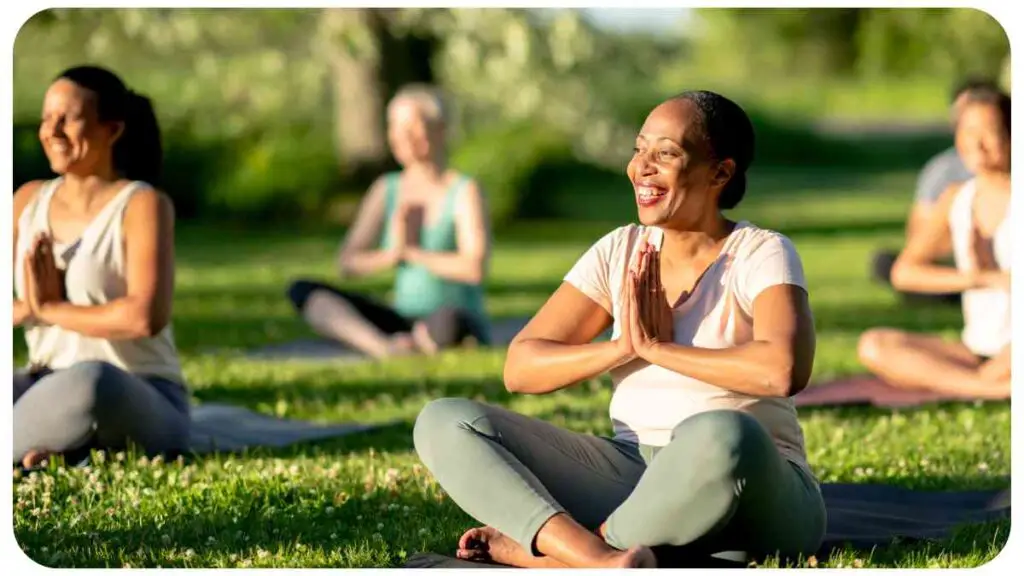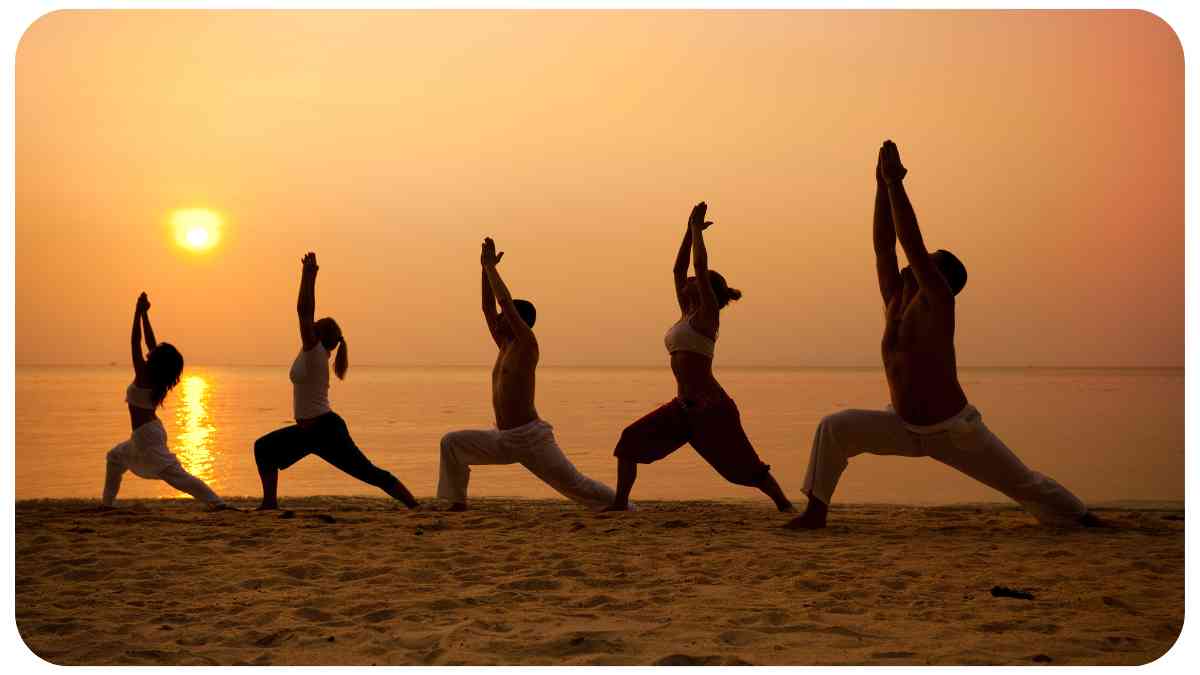Welcome to this quick guide on understanding the eight limbs of yoga. Whether you’re new to yoga or have been practicing for a while, gaining a deeper understanding of the philosophical foundation behind yoga can enhance your practice and overall well-being.
In this article, we’ll explore the eight limbs of yoga, each contributing to a holistic approach to self-discovery, self-growth, and spiritual evolution.
| Takeaway |
|---|
| The eight limbs of yoga provide a holistic framework for personal growth and spiritual evolution. |
| Incorporating the principles of Yama and Niyama in daily life cultivates self-awareness and integrity. |
| Asana practice enhances physical strength, flexibility, and mindfulness. |
| Breath control (Pranayama) and sensory withdrawal (Pratyahara) contribute to stress reduction and inner calm. |
| Concentration (Dharana) and meditation (Dhyana) develop mental clarity and a deeper connection with oneself. |
| Samadhi, the ultimate goal, is a state of blissful union with the divine or universal consciousness. |
| Through the eight limbs, one can experience improved well-being, enhanced self-awareness, and a greater sense of inner peace. |
2. The Philosophy of Yoga
Before diving into the eight limbs, let’s briefly overview the philosophy of yoga. Originating in ancient India, yoga is more than just physical exercise; it is a comprehensive practice that unifies the body, mind, and spirit. It seeks to create harmony within ourselves and with the world around us. The eight limbs provide a roadmap on this journey of self-realization and transformation.
Building a strong connection between yoga and spirituality is essential for tapping into the deeper meaning of your practice. Explore our comprehensive guide on Yoga and Spirituality: How to Tap into the Deeper Meaning of Your Practice to gain insights into the transformative power of this union.
3. The Eight Limbs of Yoga
The eight limbs, known as “Ashtanga Yoga” in Sanskrit, serve as guidelines for living a purposeful and meaningful life. Each limb builds upon the previous one, providing a framework for personal and spiritual growth. Let’s explore these limbs in detail:
3.1 Yama

Yama, the first limb, focuses on our relationships with others and the world. It consists of five ethical principles that provide guidance on how to interact in a compassionate and harmonious way. The table below summarizes the yamas:
| Yama | Description |
| Ahimsa | Non-violence towards oneself and others |
| Satya | Truthfulness in thoughts, words, and actions |
| Asteya | Non-stealing and practicing non-greediness |
| Brahmacharya | Moderation and conservation of energy |
| Aparigraha | Non-possessiveness and letting go of attachments |
3.2 Niyama
Niyama, the second limb, focuses on self-discipline and inner-strength. It consists of five observances that help cultivate a virtuous and disciplined life. The table below outlines the niyamas:
| Niyama | Description |
| Saucha | Cleanliness of body, mind, and environment |
| Santosha | Contentment and finding happiness within |
| Tapas | Self-discipline and determination in practice |
| Svadhyaya | Self-study and continuous self-improvement |
| Ishvara Pranidhana | Surrender to a higher power and letting go |
3.3 Asana
Asana, the third limb, is what most people commonly associate with yoga—the physical postures. Practicing asanas helps develop physical strength, flexibility, balance, and mindful awareness. It is through asanas that we learn to connect the body, mind, and breath. Here are some popular asanas to get you started:
| Asana | Benefits |
| Tadasana | Improves posture and strengthens the core |
| Adho Mukha Svanasana | Relieves stress and calms the mind |
| Warrior I | Builds lower body strength and stability |
| Tree Pose | Enhances balance and focus |
| Savasana | Promotes deep relaxation and rejuvenation |
3.4 Pranayama
Pranayama, the fourth limb, concentrates on breath control. By regulating the breath, we can influence our prana (life force energy) and subsequently calm the mind, increase vitality, and improve overall well-being. Here are a few pranayama techniques to explore:
| Pranayama | Benefits |
| Ujjayi Breath | Calms the mind, reduces anxiety, and stress |
| Nadi Shodhana | Balances the energy channels in the body |
| Kapalabhati | Cleanses the respiratory system |
| Bhramari | Induces relaxation and relieves tension |
3.5 Pratyahara
Pratyahara, the fifth limb, involves withdrawal of the senses and turning inward. It is the practice of disconnecting from external stimuli to cultivate inner awareness and focus. Through pratyahara, we learn to observe our thoughts and emotions without getting carried away by external distractions.
Discover the profound spiritual benefits that yoga offers, enabling you to establish a deeper connection with your higher self. Visit The Spiritual Benefits of Yoga: How It Can Help You Connect with Your Higher Self to explore the spiritual dimensions of yoga and its ability to facilitate personal growth and self-discovery.
3.6 Dharana

Dharana, the sixth limb, refers to concentration and the ability to hold the mind steady on a single point of focus. It’s about training the mind to be attentive and present. A common Dharana practice is focusing on an object, a mantra, or the breath. This cultivates mental clarity and strengthens our ability to direct our thoughts.
3.7 Dhyana
Dhyana, the seventh limb, is meditation itself. It is a state of effortless awareness and a deepening connection with our own inner self. In Dhyana, the meditator experiences a merging or absorption with the object of meditation, beyond the distractions of the mind.
3.8 Samadhi
Samadhi, the eighth and final limb, is the ultimate goal of yoga. It is a state of deep absorption and blissful union with the divine or universal consciousness. In this state, the practitioner experiences pure awareness, transcending the boundaries of the self.
Embark on a transformative journey towards spiritual enlightenment by combining the practices of yoga and meditation. Our informative guide on Yoga and Meditation: The Perfect Combination for Spiritual Enlightenment will equip you with the knowledge and techniques needed to deepen your spiritual awareness through these disciplines
4. Benefits of Practicing the Eight Limbs of Yoga
By incorporating the eight limbs of yoga into your practice, you can experience a wide range of benefits. Some of these include:
- Enhanced physical flexibility, strength, and balance through asana practice.
- Reduced stress, anxiety, and improved mental well-being through breath control and meditation.
- Improved self-discipline, integrity, and harmonious relationships through ethical principles.
- Increased self-awareness and mindfulness through sensory withdrawal and focus.
- Deepened spiritual connection and a sense of inner peace through meditation and self-reflection.
5. Tips for Incorporating the Eight Limbs of Yoga Into Your Practice
To make the most of the eight limbs and integrate them into your practice, consider the following tips:
- Begin with the yamas and niyamas. Cultivate self-awareness and self-discipline in your daily life.
- Embrace asana practice and explore different poses that resonate with you.
- Incorporate pranayama techniques to regulate and deepen your breath.
- Engage in sensory withdrawal through mindful practices and minimizing distractions.
- Practice concentration and focus to develop mental clarity and steadiness.
- Dedicate time for meditation to experience the stillness and depth of Dhyana.
- Seek guidance from experienced teachers and explore different paths of yoga.
6. Personal Journey and Experience
As a seasoned practitioner and certified yoga instructor, I’ve had the privilege of witnessing the transformative power of the eight limbs of yoga in my own life and in the lives of my students. Each limb has played a significant role in my personal journey towards self-discovery and inner peace. Let me share some insights and anecdotes from my own experience:
Find inner peace and experience spiritual growth through yoga practice. Dive into our ultimate guide on Find Inner Peace through Yoga: The Ultimate Guide to Spiritual Growth and unlock the potential of yoga as a transformative tool for enhancing your spiritual well-being.
6.1 Yama: Cultivate Integrity in Everyday Life
Practicing Ahimsa, or non-violence, helped me develop compassion not only towards others but also towards myself. By practicing Satya, truthfulness, I became more honest with myself, embracing my strengths and weaknesses with acceptance. The principle of Asteya, non-stealing, taught me the importance of contentment and letting go of desires that do not serve my highest good.
6.2 Niyama: Develop Self-Discipline and Inner-Strength
Through Saucha, cleanliness of body and mind, I learned to create a sacred space for my practice and to let go of negative thoughts and emotions. Cultivating Santosha, contentment, has shifted my focus from external achievements to finding joy in the present moment. Tapas, practicing self-discipline, has increased my commitment to my practice, even on the days when motivation was lacking.
6.3 Asana: Enhancing Physical and Mental Well-being
Asanas have been my gateway to physical and mental well-being. The practice has strengthened my body, improved flexibility, and brought a sense of vitality. Through asanas, I’ve learned to be present, to listen to my body, and to find balance in both body and mind.
6.4 Pranayama: Harnessing the Power of Breath
Pranayama has been a game-changer in managing my stress and anxiety. Regularly practicing Ujjayi breath has calmed my mind and helped me navigate challenging situations with a sense of calm and clarity. Nadi Shodhana, or alternate nostril breathing, has brought balance to my energy channels and restored a sense of harmony within.
6.5 Pratyahara: The Art of Sensory Withdrawal
In today’s fast-paced world, pratyahara has become essential for me to find moments of stillness and introspection. By consciously withdrawing from external distractions, I’ve cultivated an inner retreat where I can connect with my true self and access inner wisdom.
6.6 Dharana: Focusing the Mind and Enhancing Concentration

Dharana practices, such as candle gazing or mantra repetition, have sharpened my focus and improved my ability to concentrate. These practices have been invaluable in enhancing my productivity, both on and off the mat.
6.7 Dhyana: Cultivating a Meditative State of Mind
Dhyana, or meditation, has become an anchor in my life. Regular meditation practice has deepened my connection with the present moment and expanded my awareness. It has helped me cultivate a sense of inner calm and has been a source of inspiration and insight.
6.8 Samadhi: Attaining the Ultimate State of Bliss
While Samadhi may seem elusive, every glimpse of transcendence I’ve experienced has been a profound moment of connection with the divine. It has rekindled my faith in the transformative power of yoga and has fueled my dedication to this path.
Discover how yoga can support your weight loss journey while simultaneously nourishing your mind and body. Explore The Ultimate Guide to Yoga for Weight Loss and learn about the specific yoga poses, sequences, and practices that can aid in achieving your weight loss goals effectively.
7. Conclusion
Understanding the eight limbs of yoga provides a roadmap for holistic growth and transformation. By incorporating these principles into your practice, you can embark on a journey of self-discovery, enhanced well-being, and spiritual evolution.
Remember, as you explore each limb, bring curiosity and self-compassion to your practice. Embrace the teachings, but also find your own unique expression within the framework. May the wisdom of the eight limbs guide you towards a deeper understanding of yourself and the world around you.
Further Reading
Here are some additional resources to delve deeper into the concept of the eight limbs of yoga:
The 8 Limbs of Yoga Explained: This article on Ekhart Yoga provides a comprehensive explanation of each of the eight limbs of yoga, including practical tips for incorporating them into your practice.
The 8 Limbs of Yoga: A Comprehensive Guide: Healthline offers a detailed guide on the eight limbs of yoga, exploring their origins and the benefits they bring to physical and mental well-being.
A Full Guide to the 8 Limbs of Yoga: Alomoves provides a comprehensive guide to the eight limbs of yoga, including explanations, practice tips, and insights into how each limb can be integrated into your daily life.
FAQs
Q: What are the eight limbs of yoga? A: The eight limbs of yoga, known as Ashtanga Yoga, are Yama, Niyama, Asana, Pranayama, Pratyahara, Dharana, Dhyana, and Samadhi. They form a comprehensive framework for living a purposeful and meaningful life.
Q: How do the eight limbs of yoga contribute to personal growth? A: The eight limbs of yoga provide guidance on ethical living, asana practice, breath control, sensory withdrawal, concentration, meditation, and attaining the ultimate state of bliss. Together, they offer a holistic approach to self-discovery, personal growth, and spiritual evolution.
Q: Can I practice the eight limbs of yoga even if I’m a beginner? A: Absolutely! The eight limbs are accessible to practitioners of all levels. Start by exploring the principles of Yama and Niyama, gradually incorporate asana practice, and then explore breath control, meditation, and the deeper aspects of yoga as you feel ready.
Q: How can the eight limbs of yoga benefit my well-being? A: By following the eight limbs of yoga, you can experience numerous benefits, including improved physical strength and flexibility, reduced stress and anxiety, enhanced focus and concentration, a greater sense of self-awareness, and a deeper connection with your inner self and the world around you.
Q: Where can I find guidance on incorporating the eight limbs of yoga into my practice? A: Knowledgeable yoga teachers, workshops, and online resources can provide guidance on incorporating the eight limbs into your practice. Consider seeking guidance from experienced instructors and exploring different schools of yoga to find the approach that resonates with you.

Hello, my name is Hellen James! I am a yoga teacher and writer who loves to share information about how you can achieve a more fulfilling life. I have been practicing mindfulness, yoga, and meditation for over 10 years. My passion for these practices has led me to teach them to others.

